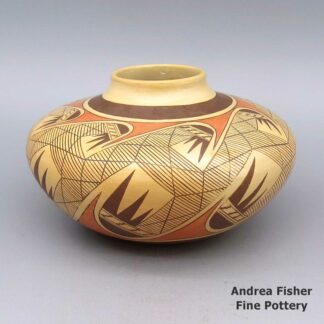Migration pattern
About the Migration Pattern Design
The "migration pattern" design seems to be specific to Nampeyo of Hano and her descendants. It is meant to signify all the migrations of the clans that have represented the various spiritual aspects of Hopi society over the last several thousand years.
The time period from about 1100 CE to about 1300 CE (non-Hopi time notation, of course) is what the Hopi refer to as "The Gathering of the Clans." The clans are reported to have traveled the Americas from north to south, east to west, and back again. Multiple times, picking up and dropping off cultural and technological items as time passed and they continually moved around. Eventually, the value of a clan and its members revolved more around what they brought to the pueblo's ceremonies rather than any form of technological or other idea they may have come with.
That time span, 1100-1300 CE is also when the Flower World ideology reached the Four Corners area and the Hopi mesas. According to some oral histories, the Hopi mesas were chosen as the best place for them to live according to the dictates of their spirituality. Life there was sufficiently hard to keep them focused on their spirituality without being overly hard. The mesas are also near where they feel they emerged into this, the Fourth World, and first took on human form.
The 1200s are also when the Katsina and Sacred Clown societies emerged. The rock art of the Southwest took on a whole other life, too, in the span of one or two generations. By 1300 most of the Rio Grande pueblos were close to where they are now, the Sinagua, Salado and Hohokam were mostly history. Before the Spanish arrived most of the Little Colorado and eastern Arizona had been abandoned. The Tsegi Canyon pueblos, the Four Corners area and Mesa Verde were almost completely depopulated. The Fremont had disappeared and the Dineh and Apaches were flooding in.
There is a story from Walpi of two distinct groups of Horn and Flute clans were approaching and asking for where they could live. One group was allowed immediate access to the village of Walpi. The other group was held off in the distance, forced to build their own pueblo from scratch and survive on their own. Several generations later came the Pueblo Revolt of 1680. It was determined to move Walpi to the top of the mesa from its foot, and to consolidate all the other, smaller, local villages into the new Walpi in the process. The differences between the two groups of Horn/Flute clan seem to have been where they came from and the depth of ceremony they brought with them.
The last large migration into the Hopi mesas was the Southern Tewa who took up residence on First Mesa, near Walpi, around 1700. By that time the only living pueblo on Antelope Mesa (east of First Mesa) was Awatovi, and Awatovi was destroyed in the winter of 1700-1701. After that, the majority of the Hopi lived up on top of their three mesas, although they farmed the valleys below. Because of how they all came together, each of the mesas has their own version of a "Hopi" language, each village their own ceremonial calendar and clan participants. The thinking is: the more clan in the village, the more powerful the village.
The interesting thing here is that the migration pattern design is basically an innovation of Southern Tewa potters, not Hopi potters (although the Southern Tewa are now known as Hopi-Tewa). The Tewa have incorporated more of the Hopi rituals into their ceremonies but there are still a few differences. And the Tewa are allowed to speak Hopi but the Hopi are not allowed to speak Tewa, from an agreement made between the Tewa elders and the elders of Walpi around 1700. The Tewa also produce a lot more pottery than their nearby neighbors.
Showing all 3 results
-

James Nampeyo, zzho3b568, Polychrome jar with a migration pattern design
$3,200.00 Add to cart -

Leah Nampeyo, leho2h293, Polychrome jar with geometric design and fire clouds
$425.00 Add to cart -

Neva Nampeyo, zzho2h336: Polychrome jar with geometric design and fire clouds
$750.00 Add to cart
Showing all 3 results